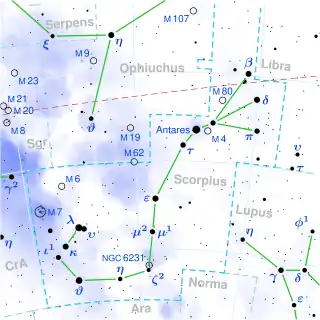Iota1 Scorpii
Iota1 Scorpii, Latinized from ι1 Scorpii, is a star in the southern constellation of Scorpius. With an apparent visual magnitude of 3.03,[2] this star can be seen with the naked eye. It is sometimes called by the proper name Apollyon.[11] Parallax measurements place it at a distance of roughly 1,930 light-years (590 parsecs) from Earth, with a 9% margin of error.[1]
 | |
| Observation data Epoch J2000 Equinox J2000 | |
|---|---|
| Constellation | Scorpius |
| Right ascension | 17h 47m 35.08113s[1] |
| Declination | −40° 07′ 37.1893″[1] |
| Apparent magnitude (V) | 3.03[2] |
| Characteristics | |
| Spectral type | F2 Ia[3] |
| U−B color index | +0.26[2] |
| B−V color index | +0.51[2] |
| Astrometry | |
| Radial velocity (Rv) | −26.00[4] km/s |
| Proper motion (μ) | RA: +0.01[1] mas/yr Dec.: −6.24[1] mas/yr |
| Parallax (π) | 1.69 ± 0.15 mas[1] |
| Distance | 1,900 ± 200 ly (590 ± 50 pc) |
| Absolute magnitude (MV) | −5.85[5] |
| Details | |
| Mass | 12.1[6] M☉ |
| Radius | 125[7] to 400[8] R☉ |
| Luminosity | 18,249[9] L☉ |
| Surface gravity (log g) | 0.5 to 1.0[10] cgs |
| Temperature | 6,910 to 7,103[10] K |
| Metallicity [Fe/H] | −0.13 to −0.11[10] dex |
| Age | 17.0 ± 0.5[6] Myr |
| Other designations | |
| Database references | |
| SIMBAD | data |
This star has a stellar classification of F2 Ia,[3] with the 'Ia' luminosity class indicating this is a supergiant more luminous than typical supergiants. It has about 12 times the Sun's mass[12] and is radiating about 35,070 times the Sun's luminosity.[12] The radius is uncertain, with estimates ranging from 125[7] to 400[8] times that of the Sun. The effective temperature of the outer envelope is about 7,000 K,[13] which gives it a yellow-white hue typical of an F-type star.[14]
Iota1 Scorpii has a 10th magnitude companion at an angular separation of 37.5 arcseconds, which, at the distance of this star, gives it a projected separation of 20,000 Astronomical Units (AU). As the relative separation of the two stars along the line of sight to the Earth is not known, however, this distance represents only a minimum value for their separation.[7]
References
- van Leeuwen, F. (November 2007), "Validation of the new Hipparcos reduction", Astronomy and Astrophysics, 474 (2): 653–664, arXiv:0708.1752, Bibcode:2007A&A...474..653V, doi:10.1051/0004-6361:20078357, S2CID 18759600
- Johnson, H. L.; et al. (1966), "UBVRIJKL photometry of the bright stars", Communications of the Lunar and Planetary Laboratory, 4 (99): 99, Bibcode:1966CoLPL...4...99J
- Houk, Nancy (1978), "Michigan catalogue of two-dimensional spectral types for the HD stars", Ann Arbor: Dept. Of Astronomy, Ann Arbor: Dept. of Astronomy, University of Michigan, 2, Bibcode:1978mcts.book.....H
- De Bruijne, J. H. J.; Eilers, A.-C. (2012). "Radial velocities for the HIPPARCOS-Gaia Hundred-Thousand-Proper-Motion project". Astronomy & Astrophysics. 546: A61. arXiv:1208.3048. Bibcode:2012A&A...546A..61D. doi:10.1051/0004-6361/201219219. S2CID 59451347.
- Anderson, E.; Francis, Ch. (2012), "XHIP: An extended hipparcos compilation", Astronomy Letters, 38 (5): 331, arXiv:1108.4971, Bibcode:2012AstL...38..331A, doi:10.1134/S1063773712050015, S2CID 119257644.
- Tetzlaff, N.; Neuhäuser, R.; Hohle, M. M. (January 2011), "A catalogue of young runaway Hipparcos stars within 3 kpc from the Sun", Monthly Notices of the Royal Astronomical Society, 410 (1): 190–200, arXiv:1007.4883, Bibcode:2011MNRAS.410..190T, doi:10.1111/j.1365-2966.2010.17434.x, S2CID 118629873
- Kaler, James B., "Iota-1 Scorpii", Stars, University of Illinois, retrieved 2012-01-12
- Pasinetti-Fracassini, L. E.; et al. (February 2001) [November 2000 (arXiv)], "Catalogue of Stellar Diameters (CADARS)", Astronomy and Astrophysics, 367 (2): 521–524, arXiv:astro-ph/0012289, Bibcode:2001A&A...367..521P, doi:10.1051/0004-6361:20000451, S2CID 425754
- McDonald, I.; Zijlstra, A. A.; Boyer, M. L. (2012). "Fundamental parameters and infrared excesses of Hipparcos stars". Monthly Notices of the Royal Astronomical Society. 427 (1): 343–357. arXiv:1208.2037. Bibcode:2012MNRAS.427..343M. doi:10.1111/j.1365-2966.2012.21873.x. S2CID 118665352.
- Luck, R. Earle (2014). "Parameters and Abundances in Luminous Stars". The Astronomical Journal. 147 (6): 137. Bibcode:2014AJ....147..137L. doi:10.1088/0004-6256/147/6/137.
- Moore, Patrick (2010), The Sky at Night, Patrick Moore's Practical Astronomy, Springer, p. 97, ISBN 978-1-4419-6408-3
- Hohle, M. M.; Neuhäuser, R.; Schutz, B. F. (April 2010), "Masses and luminosities of O- and B-type stars and red supergiants", Astronomische Nachrichten, 331 (4): 349, arXiv:1003.2335, Bibcode:2010AN....331..349H, doi:10.1002/asna.200911355, S2CID 111387483
- Luck, R. E. (September 1979), "The chemical compositions of nine southern supergiant stars", Astrophysical Journal, Part 1, 232: 797–806, Bibcode:1979ApJ...232..797L, doi:10.1086/157340
- "The Colour of Stars", Australia Telescope, Outreach and Education, Commonwealth Scientific and Industrial Research Organisation, December 21, 2004, archived from the original on March 18, 2012, retrieved 2012-01-16